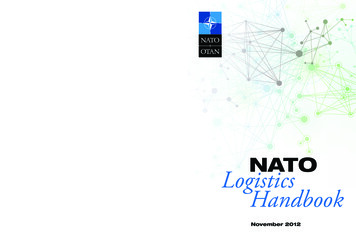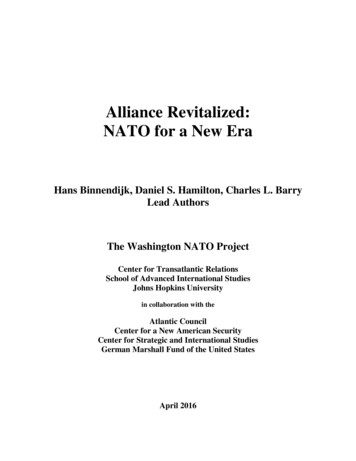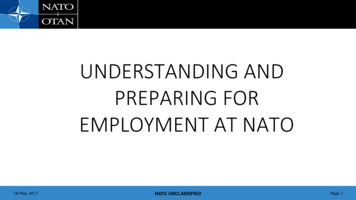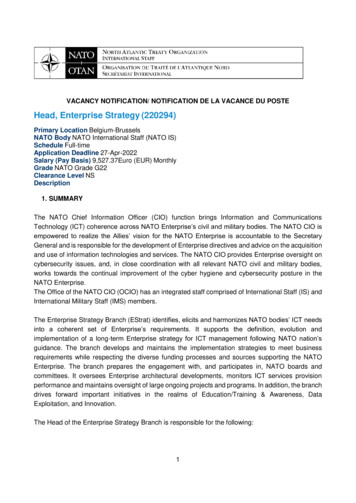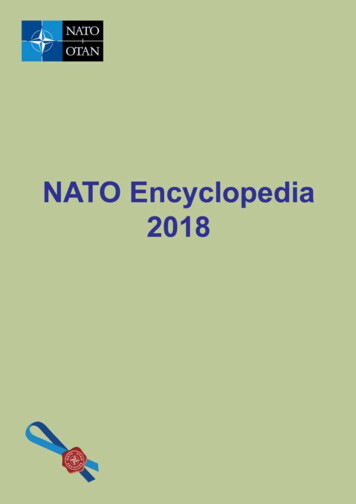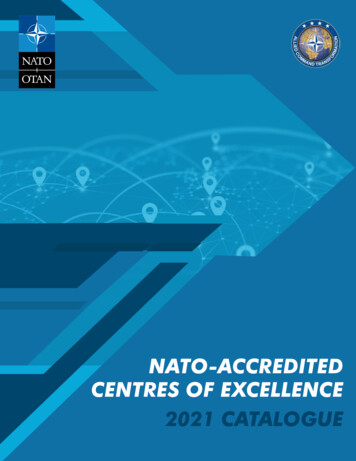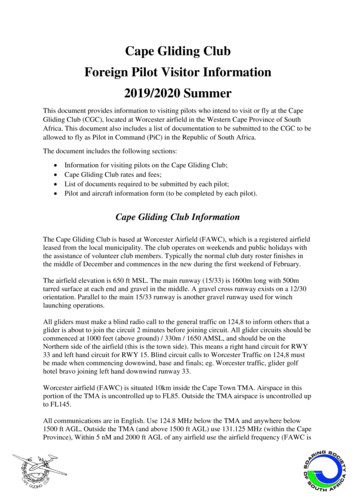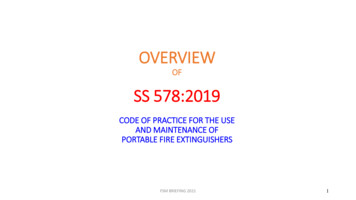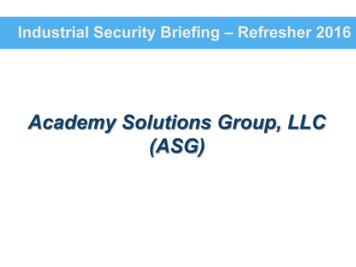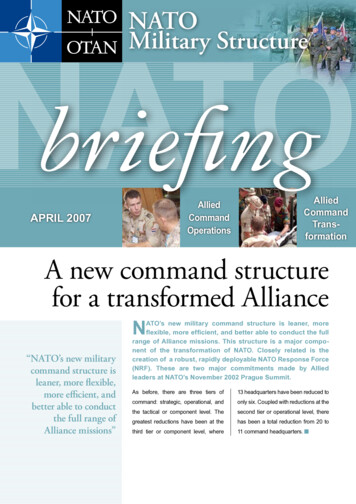
Transcription
NATOMilitary StructureNATObriefingAlliedCommandOperationsAPRIL 2007AlliedCommandTransformationA new command structurefor a transformed AllianceN“NATO’s new militarycommand structure isleaner, more flexible,more efficient, andbetter able to conductthe full range ofAlliance missions”ATO’s new military command structure is leaner, moreflexible, more efficient, and better able to conduct the fullrange of Alliance missions. This structure is a major component of the transformation of NATO. Closely related is thecreation of a robust, rapidly deployable NATO Response Force(NRF). These are two major commitments made by Alliedleaders at NATO’s November 2002 Prague Summit.As before, there are three tiers of13 headquarters have been reduced tocommand: strategic, operational, andonly six. Coupled with reductions at thethe tactical or component level. Thesecond tier or operational level, theregreatest reductions have been at thehas been a total reduction from 20 tothird tier or component level, where11 command headquarters. n
Photo by P. Rasmussen, FOVStrategic commandsThe new command structure isCommand Atlantic. The latter hasBoth commands are headed by dual-based on functionality rather thannowCommandhatted US commanders. SACEURgeography. At the first tier or strate-Transformation (ACT). Commandedcontinues to be dual-hatted as thegic level, there is now only onebyCommandercommander of the US European Com-command with an operational func-Transformation (SACT), it is respon-mand, which shares many of the sametion, Allied Command Operations,sible for promoting and overseeinggeographical responsibilities. SACTcommandedbythe continuing transformation ofis dual-hatted as the commander ofCommanderEuropeAlliancecapabilities,the US Joint Forces Command, whichIt performs the operational dutiesespecially through training and devel-is responsible for US military transfor-previouslyopment of concepts and doctrine.mation, thereby linking NATO to forts in this area. nAllied Command Operationslevel“The newcommand structuresimplifies commandarrangements forNATO operations”consistsofstandingjointforce commands in Brunssum, theheadquarters for NATO operations inthe Balkans.Netherlands, and in Naples, Italy,both of which can conduct operationsThe third tier or component/tacticalfrom their static locations or providelevel consists of six joint force compo-a land-based Combined Joint TasknentForce (CJTF, see separate section)service-specific – land, maritime orheadquarters, and a robust but moreair – headquarters to the operationalatlimited standing joint headquarters,level. Although these componentSupreme Headquarters Allied Powersin Lisbon, Portugal, from which acommands are routinely subordinatedEurope (SHAPE), near Mons, Belgium,deployable sea-based CJTF head-to the joint force commanders, theyis responsible for all Alliance opera-quarters capability can be drawn. Thecan be allocated to operations undertions, ranging from the Straits ofjoint force command in Brunssumanother commander as the needGibraltar to Afghanistan. The com-nowheadquarters,dictates. The joint force command inmand structure beneath SHAPE hasminus the maritime component, forBrunssum has an air componentbeen significantly streamlined, with athe International Security Assistancecommand in Ramstein, Germany; areduction in the number of headquar-Force (ISAF) in Afghanistan, and themaritime component command inters. The second tier or operationaljoint force command in Naples theNorthwood in the United Kingdom;AlliedCommandOperationsprovidesthe commands,whichprovide
and a land component command insupport Allied air operations fromoperations are commanded from theHeidelberg, Germany. The joint forcetheir fixed locations, while theoperational level headquarters, withcommand in Naples, Italy, has an airdeployable CAOCs will move wherestrategic direction from SHAPE.component command in Izmir, Turkey;they are needed.Thus, the Stabilisation Force whicha maritime component commandreplaced IFOR in December 1996in Naples; and a land componentThe new command structure simpli-(and was replaced by a Europeancommand in Madrid, Spain.fies command arrangements forUnion force in December 2004) wasNATO operations. While under thecontrolled operationally by the JointSupporting the air component com-previous command structure, theForce Command in Naples and themands are static and deployableImplementation Force (IFOR) inInternationalCombined Air Operations CentresBosnia and Herzegovina was com-Force (ISAF) in Afghanistan by the(CAOCs) to direct NATO air opera-manded directly by SHAPE fromJoint Force Command in Brunssum. ntions.Mons, under the new d Command Transformationplanning issues. There is a Jointfocused on transformation in specificWarfare Centre in Norway, a Jointmilitary fields will support ACT. TheyForce Training Centre in Poland,cover such areas as air operationsand the Joint Analysis and Lessonsanalysis and simulation, tactical airLearned Centre in Portugal (see sepa-operations, command and control,rate sections). ACT Headquarters alsocivil-military cooperation, cold weathersupervisesUnderseaoperations, combined operations fromResearch Centre in La Spezia, Italy.the sea, cyber defence, defenceThere are direct linkages between ACT,against terrorism, explosive ordnanceACT, with its headquarters in Norfolk,NATO schools and agencies,as well asdisposal,Virginia, is leading at the strategicthe US Joint Forces Command, withmountaineering, naval mine warfare,command level the transformationwhich ACT Headquarters is co-locatednuclear, biological and chemicalof NATO’s military structure, forces,and with which it shares its double-defence,capabilities and doctrine. It is enhanc-hatted commander. This gives it a linktraining, and policing operations. ning training, particularly of command-into US transformation initiatives anders and staffs, conducting experi-fosters a two-way street between thements to assess new concepts, andUnited States and Europe.theNATOpromoting interoperability throughoutthe Alliance.ANATOMaritimeInterdictionOperational Training Centre in Greece,ACT has a number of elements out-associated with ACT, is also envisaged.side Norfolk, including a Staff Elementat SHAPE, which is responsibleIn addition, a number of national andprimarily for resource and defencemultinational centres of excellence humanitarianPartnershipdemining,forPeace“There are directlinkages betweenACT, NATO schoolsand agencies, as wellas the US JointForces Command”
JFTC PIO Joint Warfare CentreAllied Command Transformation’ssection) train in the JWC beforeofficers and civilian staff with Iraq’sJoint Warfare Centre (JWC) intaking command of the NATO-ledMinistry of Defence and Ministry ofStavanger, Norway, formerly JointInternationalthe Interior specially selected by theHeadquarters North, provides a newForce (ISAF) in Afghanistan. Thecapability to conduct collective battleJWC also performs collective staffstaff joint training for Combined Jointtraining for new NATO nations andTask Forces, the NATO ResponsePartnership for Peace members.SecurityAssistanceIraqi authorities. nForce (NRF), component commandheadquarters,andotherNATOThe Centre is training Iraqi securityheadquarters before they deploy forpersonnel in support of the Alliance’soperations. High Readiness Forcetraining(Land) Headquarters (see separateparticipants include senior militarymissionforIraq.IraqiJoint Force Training CentreWhereas the JWC is responsible forOne of its priorities is to supportThe JFTC aims to ensure that eachoperational-level training, the JointNATO Response Force (NRF) jointNRFForce Training Centre (JFTC) inand component commanders inintegrated joint force, at a high stateBydgoszcz, the first NATO commandtraining and exercising the force. Itof training and able to deploy at shortstructure element in Poland, providesseeks to help ensure that each six-notice. This is intended to raise thecombined joint training of Alliance andmonth rotation of the NRF achievesstandards set for the NRF by SHAPEPartner forces at the tactical level toainteroperability,in each cycle as new concepts andachieve joint tactical interoperability.flexibility and training as a combinedlessons learned are continually fedIt cooperates with national andand joint force in order to be fullyback into training, thereby acting asPartnership for Peace training centres,combat ready.a catalyst for the transformation ofhighlevelofas well as centres of excellence.rotationbecomesall NATO forces. n atruly
1International Military Staff *NATO HeadquartersBrussels, Belgium122ACTNorfolk, Virginia, USA37JFC HQ BrunssumThe Netherlands4 CC-Air HQ5 CC-Mar HQRamsteinGermanyACOSHAPEMons, Belgium8Joint HQ LisbonPortugal6 CC-Land HQNorthwoodUnited KingdomDual-hatted9 CC-Air HQJFC HQ NaplesItaly10 CC-Mar esItaly11 CC-Land HQMadridSpain* The International Military Staff supports the Military Committee, which provides military advice to and answers to the North Atlantic Council.1International Military Staff *NATO HeadquartersBrussels, Belgium222ACOSHAPEMons, BelgiumNATODefense CollegeRome, Italy12ACTNorfolk, Virginia, USAACTForwardJoint ConceptDevelopmentDual-hattedFuture CapabilitiesResearch andTechnologyEducation andTraining 13SACT Representativein EuropeNATO HeadquartersBrussels, Belgium14ACT Staff ElementMons, Belgium15Joint Warfare CentreStavanger, Norway1617Joint ForceTraining CentreBydgoszcz, PolandJoint Analysisand LessonsLearned CentreMonsanto, Portugal18 NATO UnderseaResearch CentreLa Spezia, Italy19 NATO SchoolOberammergau,Germany20NATOCommunications& InformationSystems SchoolLatina, Italy21 NATO MaritimeInterdictionOperational TrainingCentreSouda Bay, GreeceCoordination with ACT required* The International Military Staff supports the Military Committee, which provides military advice to and answers to the North Atlantic Council.CommanderUSJFCOM
151/13163542/146191817122220118/109721NATO member countriesPartner countries2 ACO(Mons, Belgium)3 JFC HQ(Brunssum, The Netherlands)4 CC-Air HQ(Ramstein, Germany)5 CC-Mar HQ(Northwood, United Kingdom)6 CC-Land HQ(Heidelberg, Germany)1 IMS(NATO Headquarters, Brussels, Belgium)7 Joint HQ(Lisbon, Portugal)8 JFC HQ(Naples, Italy)9 CC-Air HQ(Izmir, Turkey)10 CC-Mar HQ(Naples, Italy)11 CC-Land HQ(Madrid, Spain)1 IMS(NATO Headquarters, Brussels, Belgium)12 ACT(Norfolk, Virginia, USA)18 NATO Undersea Research Centre(La Spezia, Italy)13 SACT Representative in Europe(NATO Headquarters, Brussels, Belgium)19 NATO School(Oberammergau, Germany)14 ACT Staff Element(Mons, Belgium)20 NATO Communications & InformationSystems School(Latina, Italy)15 Joint Warfare Centre(Stavanger, Norway)16 Joint Force Training Centre(Bydgoszcz, Poland)17 Joint Analysis & Lessons Learned Centre(Monsanto, Portugal)21 NATO Maritime Interdiction OperationalTraining Centre(Souda Bay, Greece)22 NATO Defense College(Rome, Italy)
Joint Analysis and Lessons Learned CentreThe Joint Analysis and Lessonsoperations and exercises, and moni-The JALLC mainly produces analysisLearned Centre (JALLC) located intors the process to implement thereports, NATO and PfP lessonsMonsanto, on the west side of Lisbon,lessons learned. The Centre will even-learned databases and related reme-Portugal, conducts analysis of real-tually conduct analysis of 10-12 exer-dial actions databases, and otherworld NATO and Partnership forcises a year, mostly at the operationalanalytical documents. These productsPeace (PfP) joint military operationsand tactical levels and sometimes atare distributed via print media, CDs,and exercises, maintains a lessonsthe strategic or technical levels.and websites on the NATO-wide weblearned database drawn from theseand the Internet. nSupporting the NATO Response ForceThe new NATO command structureof duty following appropriate trainingNRF 3 and 4 between June 2004plays an important role supportingand certification.and July 2005 were commanded bythe NATO Response Force (NRF),the Joint Force Command in Naples.the Alliance’s rapidly deployableAt the strategic level, SHAPE is inNRF 5 and 6 between July 2005 andmultinational unit made up of land,charge of standards, certification ofJuly 2006 were commanded by Jointair, maritime and special forces com-forces, and exercises for the NRF,Headquarters Lisbon. Starting withponents. The force, which is on con-while ACT is responsible for adaptingNRF 7 in July 2006, operationalstant standby at high readiness, isfuture capabilities, including emerg-command of the force has alternatedcomposed of national elements rota-ing technologies, and developing theamong these headquarters everyting through it on six-month periodsdoctrine for the force and training thesix months.NRF at its joint training centres inNorway and Poland. Operational andThe land, air and maritime compo-component command of the NRFnents of the NRF can be commandedrotates every six months to shareby the third-tier component com-the burden and to keep all head-mands, for six-month rotations. nquarters at the same level of trainingand readiness.Operational command of the NRFalternates among the three secondtier headquarters. Thus, NRF 1 andNRF 2, the prototypes of the forcebetween October 2003 and June2004, were commanded by the JointForceCommand inBrunssum.“Operationalcommand of theNATO Response Forcealternates amongthe three second-tierheadquarters”
Combined Joint Task ForcesThesecond-tierheadquartersinreflect their readiness to make NATOon the command and control arrange-Brunssum, Naples and Lisbon areassets available, on the basis of case-ments for such operations. The role ofbeing trained and equipped to gen-by-case decisions by the North AtlanticCJTF headquarters is therefore crucial.erate Combined Joint Task ForcesCouncil, for operations led by theA CJTF headquarters will be formed(CJTFs). The NATO Response Force’sWestern European Union, thereby sup-around core elements from selectedair, land and maritime components areporting the building of the Europeanparent headquarters of the NATO com-commanded by a CJTF generated bySecurity and Defence Identity. In addi-mand structure. It will be augmentedone of these headquarters.tion, they linked the development offrom other NATO headquarters and bythe CJTF concept to practical political-nations and contributing Partner coun-A CJTF is a multinational (combined)military cooperation in the context oftries as necessary, using a modularand multi-service (joint) task forcethe Partnership for Peace programme.approach, in order to meet the require-organised for a specific mission (task)ments of the specific mission.and formed for the full range of theThe need which the concept was cre-Alliance’s military missions requiringated to fulfil, arose from the changingA number of trials of the CJTF conceptmultinational and multi-service com-security situation in Europe and thehave been completed, for example,emergence of smaller but diverse andExercise Allied Effort in Novemberunpredictable risks to peace and sta-1997, in which a number of Partnerbility. In particular, it was agreed thatcountries participated as observers;future security arrangements wouldand Exercise Strong Resolve in Marchcall for easily deployable, multina-1998, in which Partner countries par-tional, multi-service military formationsticipated and were integrated through-tailored to specific kinds of militaryout the structure of the CJTF. The aimtasks. These included humanitarianof the trials was to validate the evolvingrelief, peacekeeping and peaceCJTF headquarters concept.enforcement, as well as collectivemand and control by a CJTF head-defence. The forces required wouldBased on these trials and other rel-vary according to the circumstancesevant staff analyses, the Allianceand would need to be generatedbegan the full implementation of therapidly and at short notice.CJTF concept in 1999. This process, which included the acquisition ofquarters. It may include elements fromAt the core of the CJTF concept whichnecessary headquarters support andevolved to meet these needs, are thecommand, control and communica-The CJTF concept was launched incommand and control arrangementstions equipment, was evaluated at thelate 1993 and was endorsed at theessential to allow such forces to oper-end of 2004. The implementation proc-January 1994 Brussels Summit, whenate effectively. The wide variety of cir-ess is taking fully into account lessonsAllied leaders directed that the furthercumstances under which CJTFs mightlearned from NATO-led operations indevelopments of the concept shouldoperate places considerable demandsthe Balkans. nnon-NATO troop-contributing nations.10
Command of deployed operationsCombined Joint Task Forces and the NATO Response ForceA Combined Joint Task Force (CJTF)generate,whenrequired,CJTFassets available, on the basis ofis a multinational (combined) andheadquarters able to command acase-by-case decisions, for opera-multi-service (joint) task force formedmajor joint operation and the newtions led by the Western Europeanfor a specific mission (task) fromsmallerDeployableUnion, thereby supporting the build-within the full spectrum of AllianceJoint Task Force (DJTF) headquartersing of the European Security andmilitary missions requiring multina-which commands the NRF. Both areDefence Identity. In addition, thetional and multi-service commandgenerated from a core DJTF head-development of the CJTF conceptand control by a CJTF headquarters.quarters staff element in each of thewas linked to practical political-mili-It may include elements from non-three joint headquarters. It containstary cooperation in the context of theNATO troop-contributing nations. Theall the principal staff functions andPartnership for Peace programme. ItNATO Response Force (NRF) is athe key elements of the commandcontinues to evolve and now reflects,smaller but higher readiness and highlygroup. These headquarters will betogether with the NRF, the transfor-capable combined joint force optimisedaugmented from other NATO head-mation of NATO from an era whenfor rapid intervention. Both requirequarters, by Allies and as appropriateArticle 5 (collective self-defence)dedicated command and control.by contributing Partner countries.dominated planning to the new, lessnon-standing,predictable security environment andThe second-tier headquarters inThe CJTF concept, launched at theNATO’s readiness to conduct com-Brunssum, Naples and Lisbon are1994 Brussels Summit, also reflectedbined joint expeditionary operationsbeingAllies’ readiness to make NATOas and where necessary. ntrainedandequippedtoFor more information, please see www.nato.int/ims www.nato.int/aco www.act.nato.int11
Prior to building a new NATO command 1stGerman-NetherlandsCorpslevel of a NATO naval task force made upstructure, Allies had already establishedHeadquarters in Münster, Germany;of dozens of warships. Three such head-as part of the new force structure six High NATO Rapid Deployable Corps-Italyquarters have been certified by SHAPE:Readiness Forces (Land) HeadquartersHeadquarters in Solbiate Olona, close Headquarters Commander Italianto Milan, Italy; NATO Rapid Deployable Corps-SpainHeadquarters in Valencia, Spain;Maritime Forces on board the ItalianNavy aircraft carrier Garibaldi; Headquarters Commander Spanish NATO Rapid Deployable Corps-Maritime Forces on board theTurkey Headquarters in Istanbul,Spanish Navy landing ship dockTurkey;Castilla; Rapid Reaction Corps-France inLille, France; Eurocorps in Strasbourg, France,sponsored by Belgium, France,BRIEF-MCS-ENG-0407High Readiness Forces and Headquarters in theNATO force structure Headquarters Commander UnitedKingdom Maritime Forces on boardthe British Royal Navy aircraft carrier HMS Ark Royal.Germany, Luxembourg and Spain.modelled on the Allied Rapid ReactionEurocorps has a different interna-Two more High Readiness ForcesCorps (ARRC) and supplemented bytional military status than the other(Maritime) Headquarters are beingother headquarters at lower readiness.five headquarters but has signed aprepared, one by France, for theThese deployable headquarters can com-technical arrangement with AlliedCommander French Maritime Forcesmand and control forces from the size ofCommand Operations and can alsoinitially on board the aircraft carriera brigade numbering thousands of troopsbe committed to NATO missions.Charles de Gaulle and in future thelanding ship dock Mistral, and the otherup to a corps of tens of thousands.These headquarters are taking turnsby NATO’s Naval Striking and SupportSHAPE has certified seven Highcommanding the International SecurityForces,Readiness Forces (Land) Headquarters:Assistance Force in Afghanistan for six-which is dual-hatted with the US Sixth ARRC Headquarters in Rheindahlen,to nine-month rotations. They also takeFleet, on board the command ship USSnear Mönchengladbach, Germany,turns providing the six-month rota tingMount Whitney. STRIKFORNATO willwith the United Kingdom as frame-land component command of the NATObe able to command an expandedwork nation, providing nearly 60 perResponse Force.NATO task force. nNATO(Strikfornato),Deployable High Readiness Forcesthe corps, as well as combat service(Maritime) Headquarters can commandand combat service support units;and control assigned forces up to theNATO Briefings address topical Alliance issues. They are published under the authority of the Secretary General and do not necessarilyreflect official opinion or policy of member governments or of NATO.NATO Public Diplomacy Division, 1110 Brussels, Belgium - Website: www.nato.int - Email: natodoc@hq.nato.int NATOnel and assigning its two divisions to2007cent of the headquarters person-
the sea, cyber defence, defence against terrorism, explosive ordnance disposal, humanitarian demining, mountaineering, naval mine warfare, nuclear, biological and chemical defence, Partnership for Peace training, and policing operations. n and a land component command in Heidelberg, Germany. The joint force
